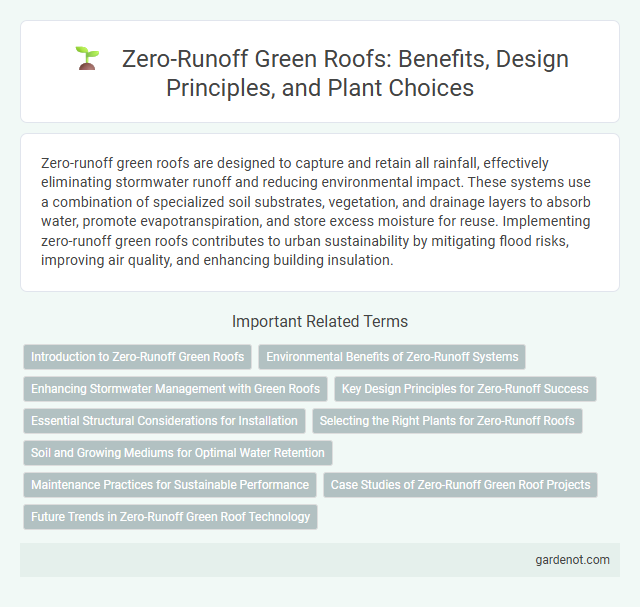Zero-runoff green roofs are designed to capture and retain all rainfall, effectively eliminating stormwater runoff and reducing environmental impact. These systems use a combination of specialized soil substrates, vegetation, and drainage layers to absorb water, promote evapotranspiration, and store excess moisture for reuse. Implementing zero-runoff green roofs contributes to urban sustainability by mitigating flood risks, improving air quality, and enhancing building insulation.
Introduction to Zero-Runoff Green Roofs
Zero-runoff green roofs are designed to capture and retain all rainfall, preventing any stormwater from draining off the roof surface. These systems use advanced soil substrates, high-absorption plants, and engineered drainage layers to maximize water retention and evapotranspiration. By eliminating runoff, zero-runoff green roofs reduce urban flooding, improve water quality, and enhance building energy efficiency.
Environmental Benefits of Zero-Runoff Systems
Zero-runoff green roofs significantly reduce stormwater runoff by retaining and absorbing rainwater, which helps mitigate flooding and decreases the burden on municipal drainage systems. These systems improve urban air quality by supporting vegetation that filters airborne pollutants and lowers ambient temperatures through evapotranspiration. Enhanced biodiversity and habitat creation on zero-runoff green roofs contribute to ecological balance in densely built environments.
Enhancing Stormwater Management with Green Roofs
Zero-runoff green roofs significantly enhance stormwater management by capturing and retaining rainfall, reducing surface runoff volume by up to 80%. These green roofs utilize specialized soil layers and vegetation to maximize water absorption and delay peak flow rates, mitigating urban flooding risks. Integrated with smart irrigation systems, zero-runoff green roofs support sustainable water cycles and improve overall urban resilience.
Key Design Principles for Zero-Runoff Success
Zero-runoff green roofs rely on key design principles including high-capacity water retention layers, use of drought-tolerant native plants, and efficient drainage systems that promote water absorption without runoff. Incorporating lightweight, engineered soil substrates maximizes water storage while maintaining structural integrity. Proper slope design and integration of overflow mechanisms ensure excess water is managed sustainably, preventing external drainage.
Essential Structural Considerations for Installation
Zero-runoff green roofs require robust load-bearing structures to support saturated soil and vegetation weight, ensuring safety and durability. Proper waterproofing membranes and root barriers are essential to prevent water leakage and root penetration that could compromise the building envelope. Adequate drainage layers must be integrated to manage water retention while avoiding excess accumulation, optimizing stormwater control.
Selecting the Right Plants for Zero-Runoff Roofs
Selecting drought-tolerant and deep-rooted plants is essential for zero-runoff green roofs to enhance water absorption and minimize runoff. Native species such as sedums, grasses, and succulents provide resilience and require minimal irrigation, optimizing stormwater retention. Proper plant selection also promotes biodiversity and maintains the roof's structural integrity by preventing soil erosion and reducing maintenance needs.
Soil and Growing Mediums for Optimal Water Retention
Zero-runoff green roofs utilize advanced soil and growing mediums engineered for superior water retention, reducing stormwater discharge effectively. These specialized substrates combine lightweight materials with high porosity and organic matter to maximize moisture absorption and retention capacity. Optimizing soil composition enhances plant health and sustains evapotranspiration, crucial for maintaining the zero-runoff objective in urban environments.
Maintenance Practices for Sustainable Performance
Zero-runoff green roofs require regular inspection of drainage systems to ensure water retention layers function effectively for sustainable performance. Routine removal of debris and monitoring plant health prevent blockages and maintain optimal evapotranspiration rates. Implementing sustainable maintenance practices such as soil nutrient management and periodic vegetation pruning enhances long-term runoff control and roof durability.
Case Studies of Zero-Runoff Green Roof Projects
Case studies of zero-runoff green roof projects demonstrate significant stormwater management benefits, with installations reducing runoff volume by up to 100% during heavy rainfall events. Examples include the Chicago City Hall green roof, which captures and retains over 90% of annual precipitation, and the Vancouver Convention Centre rooftop, designed to filter and reuse stormwater on-site. These projects highlight the potential of zero-runoff green roofs to mitigate urban flooding, improve water quality, and enhance building sustainability.
Future Trends in Zero-Runoff Green Roof Technology
Zero-runoff green roof technology is advancing with innovations in highly absorbent substrates and integrated water recycling systems designed to capture and reuse rainwater efficiently. Future trends emphasize the use of smart sensors and IoT-enabled monitoring to optimize water retention and reduce urban flooding risks. Emerging materials like biochar-enhanced media are being developed to improve soil moisture retention and support sustainable stormwater management.
Zero-runoff green roof Infographic

 gardenot.com
gardenot.com